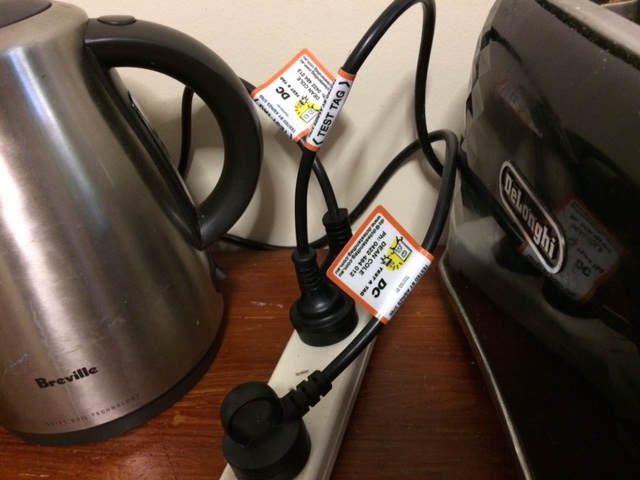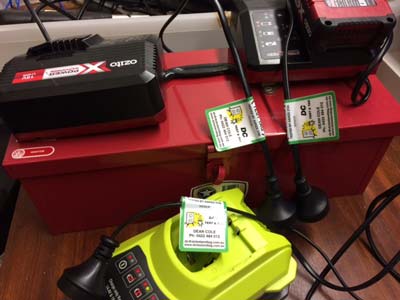FAQ’s
What Is ( AS/NZS 3760 ) ?
A document written by Standards Australia that specifies the procedures and criteria for the in-service safety inspection and testing of electrical equipment which is designed for connection by a flexible cord. It also applies to cord extension sets, portable outlet devices, portable residual current devices and portable isolation transformers. Appendices include detailed test methods.

Who May Authorise Workers to ‘Test and Tag’?
Irrespective of who does the work, the worker must be authorised by the employer for the workplace. The person authorising the work must be satisfied that:
- the inspection and testing program is appropriate and adequate for the needs of the workplace; and
- the workers carrying out testing and tagging are competent to do the work (i.e. licensed electrician or appropriately trained competent person).
Note: Competent persons will need to produce their statement of attainment or certificate on request to an employer, WorkSafe or mines inspector as appropriate, main contractor, labour hire organisation, a person having control of or control of access to a workplace, or an elected occupational safety and health representative.
What Happens with Damaged or Non-Complying Equipment?
People who inspect and test portable electrical equipment and RCDs have a responsibility to:
- identify any defects affecting safety
- record and label faulty equipment.
Where testing identifies equipment that is damaged or non-complying, it must be withdrawn from service immediately.
When electrical equipment or an RCD at a workplace has been damaged such that the risk of injury or harm to a person is increased, the employer, main contractor, self employed person, or person having control of or control of access to the workplace must ensure that the item is:
- immediately tagged ‘out of service’ against further use; and
- a competent person assesses the item or
- the item is discarded

The competent person should assess the extent of the damage and advise the nature of the damage and whether the item can be repaired.
For electrical equipment, including cords and plugs, connected to a supply of electricity of up to 240 V, the competent person may undertake ‘like-for-like’ replacement of components.
However, any other or further repairs should only be performed by a licensed electrician, the equipment manufacturer or an authorised service agent. After components have been replaced or other repairs completed, the electrical equipment must be inspected and tested by the competent person before returning it to service.
What Equipment Needs to be Tested?
Any appliance within a business that has a flexible cord that plugs into either a single phase 240V power outlet or 3 phase 415V power outlet needs to be tested regularly to ensure that the appliance is electrically safe to use within the workplace. These appliances include anything from computers to toasters, or drills and other tools to factory machinery. Any appliance within the workplace that is under 16kg or is over 16kg but has a carry handle (which makes it portable), needs to be tested, and continue to be tested in order to adhere to Occupational Health and Safety regulations, and comply with Australian Standards AS/NZ 3760.

What Does Test And Tagging Involve?
The process of testing appliance involves the following:
Visual Inspection: The most important test is a Visual Inspection of the device, especially leads. Cords should be firmly anchored in plugs, connections made solidly with no frayed ends. Copper terminals should be clean and not pitted.
Record Keeping: Although the AS3760 does not refer to record keeping upon completion of any test, various codes of practices refer to this. In spite of this we recommend all information be recorded comprehensively, whether in a database or by hand in a log book.
Tags: A safety tag must be placed on the appliance verifying its safe approval. This tag must clearly display:
- The name of the tester or test companies
- The date tested or retest date
The above are the only things that are outlined in Australian Standards, however we recommend that the tag should contain both the name of the tester and the test company name, and both the date tested and the retest date.

How Often Do I Have To Get My Equipment Tested?
 Every work situation is different and the frequency of testing depends on the harshness of the environment in question. There may be multiple environments in the one workplace, which means that some appliances may need to be retested in as little as 3 months if the surroundings are harsh. However, if the surrounding environment is less detrimental to the appliance itself, retest dates may extend to a period of anywhere up to 5 years.
Every work situation is different and the frequency of testing depends on the harshness of the environment in question. There may be multiple environments in the one workplace, which means that some appliances may need to be retested in as little as 3 months if the surroundings are harsh. However, if the surrounding environment is less detrimental to the appliance itself, retest dates may extend to a period of anywhere up to 5 years.
Australian Standards ( AU/NZS 3760 ) clearly outline how often portable appliances in different workplace environments must be tested . Contact DC Test &Tag will assess required time frames prior to testing.
Why Should I Test And Tag My Electrical Equipment?
 As individuals and the broader community alike become more aware and concerned with adhering to Occupational Health and Safety laws, great care has to be taken to avoid accidents in the workplace. The presence of regulations protecting employees against company negligence, means that the prosecution of the employer in cases of negligence is much more likely and harsher penalties are faced, than were in the past.
As individuals and the broader community alike become more aware and concerned with adhering to Occupational Health and Safety laws, great care has to be taken to avoid accidents in the workplace. The presence of regulations protecting employees against company negligence, means that the prosecution of the employer in cases of negligence is much more likely and harsher penalties are faced, than were in the past.
A well planned program of preventive maintenance, with regular electrical safety checks, is the ideal way to avoid unnecessary and unfortunate accidents, as well as the legal ramifications that follow.
What Records of Testing and Tagging Need to be Kept?
Copies of test and tag results of all inspections, tests and maintenance should be retained by the relevant duty holder and the competent person who carried out the work if not employed by the equipment owner.
In particular, the following information should be kept:
- name of the person who made the inspection or carried out the test or maintenance;
- date on which, or dates over which, the inspection was made or the test or maintenance was carried out;
- result or outcome of the inspection, test or maintenance;
- date by which the next inspection and test should be carried out;
- if applicable, licence or certificate number of the competent person who carried out the electrical inspections and tests
- if applicable, plant number or inspection number of the item or items inspected.
